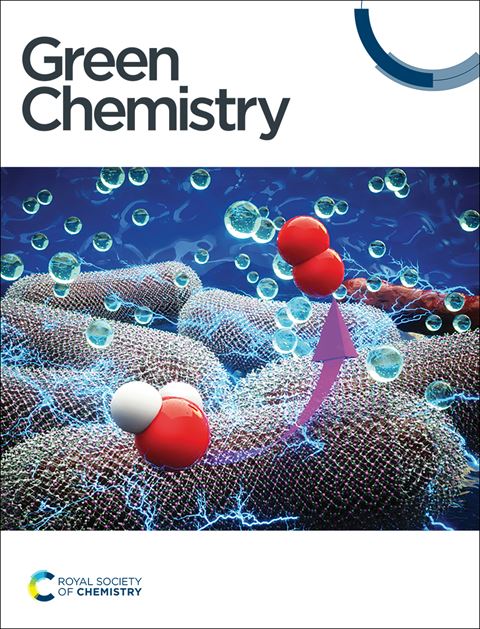结晶/非晶c-NiMo/a-NiMoOx纳米阵列用于尿素辅助碱性海水中节能制氢†
IF 9.2
1区 化学
Q1 CHEMISTRY, MULTIDISCIPLINARY
引用次数: 0
摘要
电催化海水裂解被认为是生产绿色氢气(H2)的最有效方法,但它面临着高能耗和有害的氯进化副反应等问题。用热力学上有利的脲氧化反应(UOR)取代缓慢的氧进化反应(OER),可实现节能和无氯制氢。本文报告了一种新型三维(3D)结构电催化剂(c-MoNi/a-NiMoOx),该催化剂由结晶 MoNi 合金团簇与无定形 NiMoOx 纳米线耦合而成。在氢进化反应(HER)过程中,晶体/非晶体界面的电子再分布可有效调节电子结构,从而优化水解离和氢吸附的吉布斯自由能。在 UOR 过程中,c-MoNi/a-NiMoOx 会发生表面重构,形成高活性的 β-NiMoOOH。钼的加入降低了决定速率步骤的活化能垒,从而促进了多步骤 UOR 过程的进展。令人兴奋的是,基于 c-MoNi/a-NiMoOx 的尿素辅助海水电解只需要 1.68 V 的超低电压就能提供 500 mA cm-2 的电流,并显示出卓越的长期稳定性,能在 300 小时内保持在 100 mA cm-2 以上。本文章由计算机程序翻译,如有差异,请以英文原文为准。

Crystalline/amorphous c-NiMo/a-NiMoOx nanoarrays for urea-assisted energy-saving H2 production in alkaline seawater†
Electrocatalytic seawater splitting is regarded as the most effective method for producing green hydrogen (H2), but it faces issues of high energy consumption and harmful chlorine evolution side reactions. Replacing the sluggish oxygen evolution reaction (OER) with the thermodynamically favorable urea oxidation reaction (UOR) would enable energy-saving and chlorine-free H2 production. Herein, a novel three-dimensional (3D) structured electrocatalyst (c-MoNi/a-NiMoOx) with crystalline MoNi alloy clusters coupled with amorphous NiMoOx nanowires is reported. In the hydrogen evolution reaction (HER) process, the electron redistribution at the crystalline/amorphous interface could effectively regulate the electronic structure, thereby optimizing the Gibbs free energy of water dissociation and hydrogen adsorption. In the UOR process, c-MoNi/a-NiMoOx undergoes surface reconstruction to form highly active β-NiMoOOH. The incorporation of Mo lowers the activation energy barrier of the rate-determining step, thus facilitating the progression of the multi-step UOR process. Excitingly, the urea-assisted seawater electrolysis based on c-MoNi/a-NiMoOx requires an ultralow voltage of 1.68 V to deliver 500 mA cm−2, and displays distinguished long-term stability to keep above 100 mA cm−2 for 300 h. This work may show practical impact on designing efficient electrocatalysts for combing seawater splitting with urea purification.
求助全文
通过发布文献求助,成功后即可免费获取论文全文。
去求助
来源期刊

Green Chemistry
化学-化学综合
CiteScore
16.10
自引率
7.10%
发文量
677
审稿时长
1.4 months
期刊介绍:
Green Chemistry is a journal that provides a unique forum for the publication of innovative research on the development of alternative green and sustainable technologies. The scope of Green Chemistry is based on the definition proposed by Anastas and Warner (Green Chemistry: Theory and Practice, P T Anastas and J C Warner, Oxford University Press, Oxford, 1998), which defines green chemistry as the utilisation of a set of principles that reduces or eliminates the use or generation of hazardous substances in the design, manufacture and application of chemical products. Green Chemistry aims to reduce the environmental impact of the chemical enterprise by developing a technology base that is inherently non-toxic to living things and the environment. The journal welcomes submissions on all aspects of research relating to this endeavor and publishes original and significant cutting-edge research that is likely to be of wide general appeal. For a work to be published, it must present a significant advance in green chemistry, including a comparison with existing methods and a demonstration of advantages over those methods.
 求助内容:
求助内容: 应助结果提醒方式:
应助结果提醒方式:


